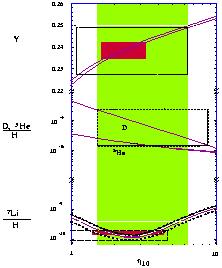

The simplicity of the standard model of Big Bang Nucleosynthesis (BBN) and its
success when confronted with observations place the theory as one of the
cornerstones of modern cosmology. BBN
is based on the inclusion of an extended nuclear
network into a homogeneous and isotropic cosmology. Apart from the
input nuclear cross sections, the theory contains only a single parameter,
namely the baryon-to-photon ratio,
 . Other factors, such
as the uncertainties in reaction rates, and
the neutron mean-life can be treated by standard statistical and Monte
Carlo techniques
[2,
3,
4,
5].
The theory then allows one to make
predictions (with specified uncertainties) of the abundances of the
light elements, D,
3He, 4He, and 7Li. As there exist
several detailed reviews on BBN, I will
briefly summarize the key results and devote this contribution to the impact of
recent observations of 4He and 7Li along with the
related observations of Be
and B. In referring to the standard model, I will mean homogeneous
nucleosynthesis, with three neutrino flavors
(N
. Other factors, such
as the uncertainties in reaction rates, and
the neutron mean-life can be treated by standard statistical and Monte
Carlo techniques
[2,
3,
4,
5].
The theory then allows one to make
predictions (with specified uncertainties) of the abundances of the
light elements, D,
3He, 4He, and 7Li. As there exist
several detailed reviews on BBN, I will
briefly summarize the key results and devote this contribution to the impact of
recent observations of 4He and 7Li along with the
related observations of Be
and B. In referring to the standard model, I will mean homogeneous
nucleosynthesis, with three neutrino flavors
(N = 3), and a
neutron mean life of 886.7 ± 1.9 s
[6].
= 3), and a
neutron mean life of 886.7 ± 1.9 s
[6].
The dominant product of big bang nucleosynthesis is 4He,
resulting in an
abundance of close to 25% by mass. Lesser amounts of the other light
elements are produced: D and 3He at the level of about
10-5 by
number, and 7Li at the level of 10-10 by
number. The resulting
abundances of the light elements are shown in
Figure 1, over the range in
 = 1010
= 1010
 between 1 and 10.
The curves for the 4He mass fraction,
Y, bracket the computed range based mainly on the uncertainty
of the neutron mean-life.
Uncertainties in the produced 7Li
abundances have been adopted from the results in Hata et al.
[3].
Uncertainties in D and
3He production are small on the scale of this figure.
The dark shaded boxes correspond
to the observed abundances and will be discussed below.
between 1 and 10.
The curves for the 4He mass fraction,
Y, bracket the computed range based mainly on the uncertainty
of the neutron mean-life.
Uncertainties in the produced 7Li
abundances have been adopted from the results in Hata et al.
[3].
Uncertainties in D and
3He production are small on the scale of this figure.
The dark shaded boxes correspond
to the observed abundances and will be discussed below.

|
Figure 1. The light element abundances from
big bang nucleosynthesis as a function o
|
At present, there is a general concordance between the theoretical
predictions and
the observational data, particularly, for 4He and
7Li
[7]. These two
elements indicate that
 lies in the range
1.55 <
lies in the range
1.55 <  < 4.45. There is
limited agreement for D/H as well, as will be discussed below. High D/H
narrows the
range to 1.5 <
< 4.45. There is
limited agreement for D/H as well, as will be discussed below. High D/H
narrows the
range to 1.5 <  < 3.4
and low D/H is compatible at the
2
< 3.4
and low D/H is compatible at the
2 level in the
range 4.2 <
level in the
range 4.2 <  < 5.3.
< 5.3.